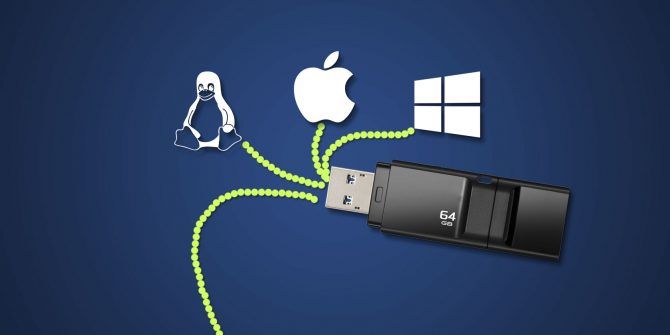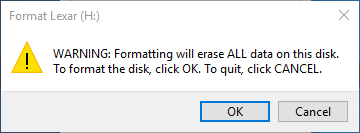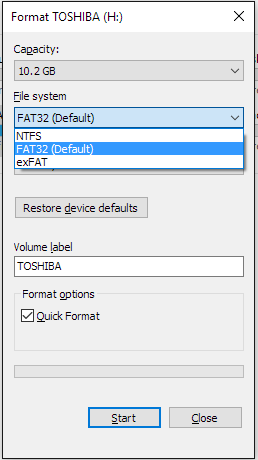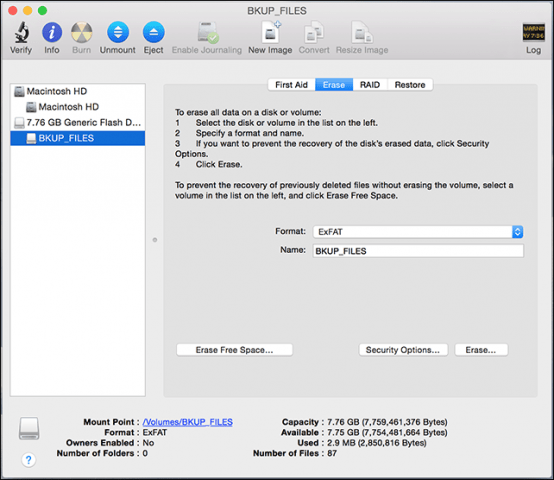Format Flash Drive Mac To Exfat
- Right-click the drive icon in the Finder sidebar (or on the desktop) and select Get Info. You will see the drive's file system shown on the right “Format”. Formatting a drive will erase it completely, so make sure you have everything backed up that you want to keep. To format a drive on a Mac, you'll need the built-in Disk Utility application.
- Step 3: To perform a quick format, type in the following command “ Format-Volume -DriveLetter DRIVE-LETTER -FileSystem exFAT ”. Replace 'DRIVE-LETTER' with the drive letter allocated to your flash drive by the PC. For this example, the command looks like this, “ Format-Volume -DriveLetter D -FileSystem exFAT ”.
- Part 1: How To Format Flash Drive On Mac. Here are the steps that you need to follow. Do these steps and you will then be able to format your flash drive on your Mac. Step 1: Go ahead and plug in your flash drive in the USB port on your Mac. Step 2: After that, go ahead and launch the Finder and click on your flash drive detected by your Mac.
Click the Format pop-up menu, then choose a file system format. (Optional) If available, click Security Options, use the slider to choose how many times to write over the erased data, then click OK. Secure erase options are available only for some types of storage devices.
Since the PC and Mac are two different operating systems, they use different file systems. By default, Macs use HFS, while PCs use NTFS, which are not compatible with each other. If you plan on using an external drive with both Macs and PCs, you should format the disk with the exFAT file system instead.

You can format the drive on your Mac or Windows computer.

How to format a USB drive as exFAT on Mac
So how do you know if your USB drive is in the correct format? You do not need to do anything special on the 'Disk Utility' - simply insert the USB drive and open Finder. Right-click the drive icon in the Finder sidebar (or on the desktop) and select Get Info. You will see the drive's file system shown on the right “Format”.
Formatting a drive will erase it completely, so make sure you have everything backed up that you want to keep. To format a drive on a Mac, you'll need the built-in Disk Utility application.
Go to Open Disk Utility, which is located under Applications in the Finder menu. If you have a USB flash drive inserted in your Mac, you can see it under the External in the Disk Utility. Select your flash drive from the list. Go to the Erase tab. You will be asked to provide the disk name and then select the file system as exFAT.
Then select the default GUID Partition Map (GPT) scheme. Click the Erase button when you are done and the Disk Utility will format your disk with the settings you specified. This will erase all the files on the drive.
You're now done. Be sure to eject the disk before you remove it from your Mac.
How to format a USB flash drive as exFAT on Windows PC
There are several ways to format drive in Windows PC, you can do that in This PC or in Disk Management.
Note: If you have important data on your USB flash drive, you should backup your drive before formatting it.
Option 1: Format a USB drive as EexFAT in This PC.
Press Windows logo key + E to open File Explorer. Right-click on the drive you want to format, click on Format. Under File system box, select exFAT for this drive. Then click Start button to go on.
Option 2: Format a USB drive as EexFAT in Disk Management.
Press Win+X, then hit K key to open Disk Management (diskmgmt.msc).
Right-click on the drive you want to format, select Format to see the list of configurations including file system. Select exFAT for this drive. Then click OK button to go on.
Related Articles
- How to Backup an External Hard Drive before Formatting It
- How to Create and Format a Hard Disk Partition in Windows 10
- Check and Repair Bad Sectors in USB Flash Drive
- Fix USB Device Can't be Recognized by Computer
- Recover Hidden Files in Virus-attacked USB Drive
- Password Protect a USB Flash Drive on Mac without Erasing Data
For Apple Mac users, there are two ways to format USB flash drive to FAT32, including Disk Utility and Terminal command line. Refer to detailed steps of using both tools for FAT32 format. Formatting would erase data completely, make sure that you have a data backup. Otherwise, you can use data recovery software to recover data from a formatted USB drive.
Are you looking for a secure way to format USB to FAT32 on Mac? You are at the right place. Follow here, you can find two methods that will assist you in doing so on your storage device. And if you lost data during the formatting, reliable Mac file recovery software is ready to help anytime:
| Workable Solutions | Step-by-step Troubleshooting |
|---|---|
| Method 1. Use Disk Utility | Connect USB to Mac > Go to Applications > Utilities > Disk Utility > Select USB and click 'Erase'...Full steps |
| Method 2. Use Terminal Command | Connect USB to Mac > Hit cmd + space keys > Type terminal and hit Enter...Full steps |
| Bonus Tip. Recover Formatted Data | If you lost data due to formatting, run EaseUS file recovery software > Scan and recover formatted data...Full steps |
How to Format a USB Flash Drive with Mac to FAT32
Computer users who use a USB might have the demand for formatting it to the FAT32 file system. Compare with the other commonly used NTFS file system on a flash drive, FAT32 has a compatibility advantage across many operating systems.
It's a universal format that is compatible with Mac OS X/macOS, Windows, Linux, and DOS systems. So, if users anticipate using the flash drive with more than one operating system, they will definitely benefit from the FAT32 file system. For Apple Mac users, there are two ways to format a USB flash drive to FAT32, namely Disk Utility and Terminal command line. Below are the detailed steps of the FAT32 format with both methods.
Method 1. Format FAT32 on Mac [Disk Utility]
To format USB to FAT32 with Disk Utility will erase all data on the flash drive, so before you doing so, please do remember to check whether you have saved useful data to another secure device in advance.
To format the USB drive to FAT32, follow the next steps:
Step 1. Connect the USB flash drive to your Mac computer.
Step 2. Go to Applications >Utilities > Double click and open Disk Utility.
Step 3. Select your USB flash drive on the sidebar, choose Erase.
Step 4. Rename the USB flash drive (optional).
Step 5. Choose the format as MS-DOS (FAT) for Format, Master Boot Record for Scheme. Then click Erase.
Wait for the process to complete, then you'll get an empty new USB flash drive with FAT32 as the file system. You can use it for saving data again.
Method 2. Format FAT32 on Mac [Terminal Command Line]
The command-line behavior does the same way to erase data with the Disk Utility. Again, create a backup before taking this action.
To format FAT32 on Mac with Terminal, follow the next steps:
Step 1. Connect the USB flash drive to your Mac computer.
Step 2. Hit cmd + space to run Spotlight, type: terminal, and hit Enter.
Step 3. Type: diskutil list and find out which disk is your USB drive.
Step 4. Type: sudo diskutil eraseDisk FAT32 MBRFormat /dev/disk2.
- sudo gives you user right.
- Diskutil calls disk utility program.
- eraseDisk commands to format.
- FAT32 sets the file system.
- MBRFormat tells disk utility to format with a Master Boot Record.
- /dev/disk2 is the location of the USB drive.
Wait for the process to complete. After this, you can type 'diskutil list' in the command again to check if the formatting has been successful.
Bonus Tip: How to Recover Data from Formatted USB
Formatting the USB would erase the data on it completely, so please make sure that you have a backup. If you don't, you can count on data recovery software to retrieve the lost data.
How To Format Exfat

EaseUS Data Recovery Wizard has both Windows and Mac versions, so it's a good choice for data recovery, no matter you're using a PC or Mac. For Mac users, it only takes a few clicks for the software to scan and display the formatted data. To guarantee an effective data recovery without spending money to no avail, you can install the Mac data recovery free version for the first trial. You can preview all the found data before the final recovery.

To recover data from a formatted USB flash drive on Mac, follow the next steps:

Step 1. Correctly connect your USB flash drive to your Mac. Launch EaseUS Data Recovery Wizard for Mac. Start selecting the flash drive and click 'Scan' to let the software search lost files on it.
Step 2. After a quick scan and deep scan, all files will be presented in the left panel in the scan results.
Exfat And Mac
Step 3. Select files you want to recover and click the 'Recover Now' button. Don't save the recoverable files to the USB drive itself in case of data overwriting.